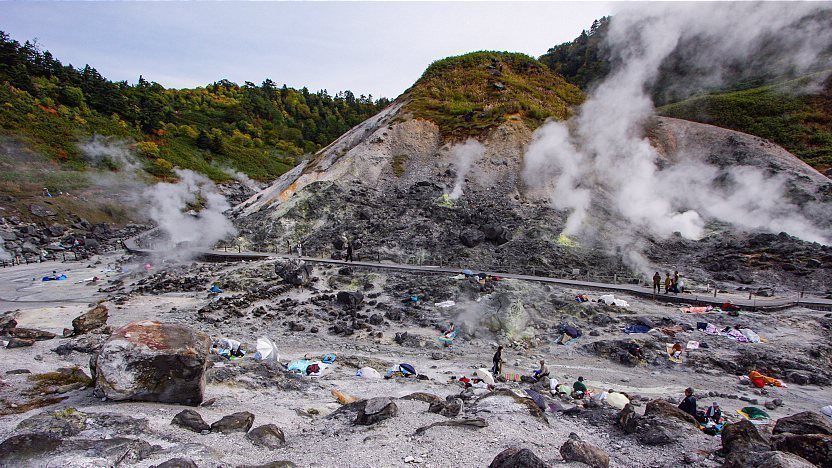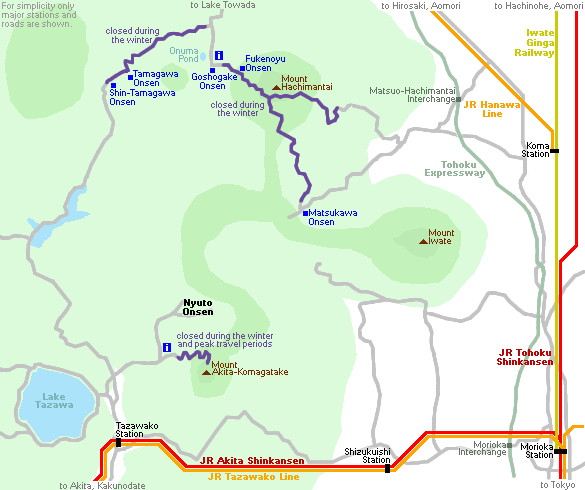Tamagawa Onsen

Tamagawa Onsen (玉川温泉) is a unique hot spring resort in the mountains of Towada-Hachimantai National Park, famous for having Japan's most acidic hot spring waters at nearly pH 1. The area also features a very rare, radioactive stone (hokutolite), that is believed to have a wide range of health effects, including the prevention and treatment of cancer, thereby attracting cancer patients from across Japan.
Tamagawa Onsen has just a single ryokan with a large number of simple rooms and a public bath, where guests can either stay overnight or use the bath on a day visit. More than other Japanese hot spring resorts, Tamagawa Onsen attracts a large percentage of guests who primarily come for health reasons rather than leisure. But regular tourists are welcome, as well. Note that the ryokan is closed during the winter months from early November to mid April.

Tamagawa Onsen's bathing facilities consist of gender separated, wooden indoor baths with multiple pools. Experienced onsen travelers will immediately notice the high acidity of the local water, which can be slightly painful if you have sensitive skin or a wound. Some pools are directly fed from the source, while others have water that was watered down to 50% to reduce the acidity. There are also some wooden steam boxes to sit in. During winter, the baths can be used by staying guests only.
Tamagawa Onsen's hot spring water surfaces spectacularly in a valley just a short walk away from the ryokan. A single source splashes out almost 9000 liters of 98 degree hot water every minute, making it Japan's single most productive hot spring source. Around it there are smaller sources, hissing sulfurous vents and streams of hot water, which can be viewed from walking paths. Along the paths you will also see many people lying on the radioactive rocks for hours for health benefits.

The volcanically active valley of Tamagawa Onsen is also the trailhead of a seven kilometer long hiking route over neighboring Mount Yakeyama to Goshogake Onsen, another volcanically active area with hot spring facilities. Autumn colors at Tamagawa Onsen are usually best around mid to late October.
Located two kilometers down the road of Tamagawa Onsen is Shin-Tamagawa Onsen ("New Tamagawa Onsen") with a second ryokan and bathing facilities fed by the same hot spring water. Unlike the Tamagawa Onsen ryokan, Shin-Tamagawa Onsen remains open during the winter months.

Getting there and around
Tamagawa Onsen can be reached by local buses or by car from the north or the south. During winter (late November to mid April), only the southern route remains open to traffic.

From Tazawako Station and Lake Tazawa
Outside winter, Tamagawa Onsen can be conveniently reached by direct buses from Tazawako Station (80 minutes, 1490 yen, one bus every 1-2 hours). The bus can also be boarded at Tazawa-kohan bus stop at the eastern shores of Lake Tazawa. From mid October to mid April, buses operate only as far as Shin-Tamagawa Onsen and only in the morning and early afternoon (65 minutes, 1470 yen).
Cars are not permitted to travel to either Tamagawa Onsen or Shin-Tamagawa Onsen from late November to mid April. Instead, car travelers should park their vehicles on a parking lot around Lake Tazawa and take a bus from there. During the rest of the year, both onsen can be reached by car in about one hour from Tazawako Station.
From Kazuno-Hanawa Station (closed in winter)
From mid April to mid October, there is one direct bus per day from JR Kazuno-Hanawa Station to Tamagawa Onsen (70 minutes, 1270 yen, not operating in 2023!). The road north of Tamagawa Onsen gets closed during winter, making access by bus or car impossible during that time.
How to get to and around Hachimantai

Hours and Fees
Tamagawa Onsen Baths (non-staying visitors)
Hours
Closed
Admission
Shin-Tamagawa Onsen Baths (non-staying visitors)
Hours
Closed
Admission
Questions? Ask in our forum.


